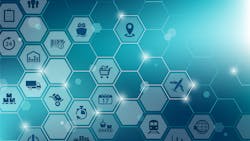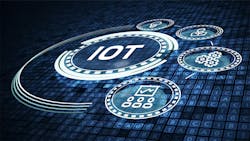2022 Technology Predictions from an Electronic Design and Test Thinktank
This article is part of the 2022 Electronic Design Forecast issue
What you'll learn:
- How COVID is impacting tech trends for 2022.
- Building up resiiency and security in supply chains.
- The democratization of IT.
- The insatiable demand for bandwidth, and the roles of 5G and 6G in this space.
In 2021, the world continued to experience an unprecedented public health crisis—the coronavirus pandemic. This has impacted all sectors of society and forced enterprises, small businesses, governments, and private institutions to pivot, in some cases extensively, to accelerate digital transformations and rethink the way innovation is achieved.
Here, Keysight executives comment on the shape-shifting business operations and technology trends that are unfolding through the lens of the pandemic, the effects of which will continue to have lasting effects on organizations and society.
The Rise of Quantum Computing
Quantum is an emerging technology that has continued to thrive during COVID from an innovation and investment perspective. 2022 will be a breakout year for quantum. The need for high-precision test and measurement will rapidly expand to enable superconducting quantum systems to realize their full potential.
Multiple 100-qubit quantum computers come to the cloud
In 2022, several companies will release quantum processor units (QPUs) to the cloud with 100 or more qubits. These breakthroughs will create new challenges for device developers, including scaling (bigger quantum computers), deploying (more calibrations), and the repeatability (yield in device fabrication) of quantum devices.
Breakthroughs in two-qubit gate error rates
Two-qubit gate error rates are currently a major limiting factor in quantum algorithm performance in finance, pharma, and logistics applications. With QPU technologies now demonstrating improvements in two-qubit gate error rates, there will be record lows in system noise in 2022, helping improve the performance of quantum processors. These advances create a new challenge to measure small gate error rates and understand QPU crosstalk reliably and efficiently.
Resilient Supply Chains
Current supply-chain disruptions (shortages of semiconductor chips and raw materials, coupled with logistics constraints like crowded ports and a shortage of truck drivers) have created bottlenecks that will continue to constrain output in 2022. Supply-chain resilience is now key to an organization's ability to navigate the ongoing volatility.
Organizations will increasingly divert efforts to future-proof supply chains to gain a competitive advantage. In addition, sustainable supply chains will be prioritized to mitigate the environmental, social, and corporate governance (ESG) risk.
- Supply chains will become more agile and digitized: Digital technologies will build new capabilities into the supply chain ecosystem. With greater automation and visibility, organizations will be more nimble and able to respond to fluctuations quickly.
- The self-driving supply chain will become a reality: As cognitive automation is widely embedded, supply chains will become more intelligent. This will lead to the automation making recommendations, predicting outcomes, and eventually making decisions autonomously.
- Business continuity planning and risk mitigation: Rather than relying on one global provider, there will be a shift to multiple sourcing and regionalization to reduce disruption. This will be a vital determinant of supply-chain resilience.
- Design for resilience: Product design will incorporate easier to source standardized parts, enabling organizations to respond quickly to disruptions. Maintaining safety stocks for critical components will replace the established “just in time” approach to inventory.
Virtual Collaboration Will Become More Sophisticated
The pandemic has shown organizations that they can be successful with a disparate workforce. In 2022, virtual collaboration will become more sophisticated, with organizations utilizing innovative technology to boost productivity. This new wave of remote collaboration will create a complex web of connected systems in which test and measurement will be essential to ensure a seamless and secure experience.
- Virtual-reality/augmented-reality/mixed-reality (VR/AR/MR) technologies will support better visualization. In product design, digital twins will create simulations of designs before building the physical product. These simulations allow remote teams to collaborate on the design, improve the overall process, and reduce the time and cost required for product development.
- Remote monitoring with automated systems, including robots in warehouses and delivery drones for logistics, will capture and consolidate data that remote workers can share and monitor in real-time.
Enterprise IT
Citizen developers will dominate by 2025
The biggest challenge and opportunity for CIOs is the democratization of IT through citizen development. A citizen developer reports to a business unit or function other than IT. By 2027, there will be five times as many citizen developers as traditional developers in organizations.
- The accelerating pace of digital transformation with every workflow becoming automated, streamlined, and interconnected is fueling the insatiable demand for more apps.
- The widespread deployment of intelligent technologies, including artificial intelligence (AI), machine learning (ML), and natural language processing (NLP) in no-code and low-code platforms, enables citizen developers to perform automation. As a result of this shift, CIOs will no longer be resource-constrained and can rapidly scale their digital transformation efforts. However, they will need to continuously monitor and test the user experience across the entire ecosystem of apps and services.
- The pivot to citizen developers will add to the security burden as CIOs will need real-time visibility into the network to ensure that citizen developers and users are secure. The rise of citizen developers depends on continuous intelligent test automation, ensuring that everything performs as users expect and that systems are secure.
In enterprise systems, cloud-first composable architectures will displace monolithic legacy architectures
- IT organizations will accelerate the digitalization of their firms through API-based integration of cloud-based solutions from a variety of vendors to achieve unprecedented levels of adaptability, functionality, customer experience, scalability, and robustness.
- Each firm will increasingly depend on the performance, reliability, and security of the networks of its cloud service vendors, solutions providers, and business partners.
- Network visibility and network digital-twin solutions will need to find new ways to promote the required levels of performance, reliability, and most importantly, security, across the networks of multiple sets of firms.
IoT
It’s all about subscription services, not devices
Connected devices are ubiquitous across industries; the key now is to deliver subscription services. In 2022, intelligent technologies will allow organizations to treat customers as a segment of one and roll out hyper-personalized services. For example:
- A smart fridge presents menu options for the week based on an individual’s preference (gluten-free) and then automatically suggests shopping lists with the preferred grocery delivery service for any missing ingredients for the meals.
- By 2025, these types of personalized services will have grown rapidly and over 50% of households (U.S.) will have a least one subscription.
Traditional industries will become subscription/usage-based
Rolls-Royce rents out its engines based on usage; trains are leased per mile. As the on-demand economy continues to expand, subscription models will expand into business and consumer markets. This includes cars, kitchen appliances, and automated services. The connected infrastructure will advise when repairs or replacements need to happen as predictive maintenance becomes the norm by 2024 to optimize the availability of these services.
Autonomous vehicles help fuel the shift to mobility as a service (MaaS)
The combination of autonomous vehicles and the move to subscription-based services aligns with a world where you no longer need to own a car. By 2025, consumers will shift to a rent-a-service model, enabling them to go wherever and whenever they like. Another advantage of autonomous vehicles is that users can optimize their locations to maximize the predicted utilization. This ensures that everyone who wants a car gets one when they need it, using the minimum number of vehicles by analyzing live and historical data to fuel predictive analytics.
IoT will transform the retail experience
- Before the end of this decade, there will be no checkout or cashiers in any retail store. Intelligent technologies and RFID tags will track every item and auto charge to a customer’s credit card/bank account, removing the friction from the physical shopping experience.
- By 2024, robots will be widely deployed both in-store and in warehouses/fulfillment centers, further shrinking the number of human jobs in the retail industry.
- Supermarkets will be the next victim of the retail apocalypse. As RFID tags become pervasive in the home and in stores, supermarkets will deliver directly from the warehouse to the customer, eliminating the need for physical stores.
- Drone delivery will become the norm by 2025 to meet the demands of younger consumers and to help accelerate the delivery of goods.
Healthcare diagnostics
In the same way IoT started to move analytics to the edge, this is now happening in healthcare. Increasingly sophisticated and accredited, devices (such as the Apple Watch) have technology that allows individual patients to perform a range of diagnostics on their own devices in their own home and in their own time. This trend will expand into new markets, delivering a range of autonomous, preliminary diagnosis solutions in most homes by 2024.
Security
Supply-chain cyber risks will soar
With the increased reliance on technology, cybersecurity risks and vulnerabilities will become a growing concern for supply chains as hackers have turned their attention to the industrial IoT and other critical infrastructure targets, including supply chains. Designing a resilient supply chain will require connecting the entire ecosystem and ensuring that unrelenting attacks from hackers aren’t successful.
By 2025, SecOps will be the number one operational priority
- With security breaches a growing threat to every industry, DevOps will finally be superseded by DevSecOps in 2022 as businesses realize that security must take center stage in a hyper-connected digital world.
- Information technology security and operations teams will collaborate and integrate tools, processes, and technology to keep organizations secure. Security auditing and self-directed attacks will be the only viable way to mitigate risk.
Standards will be introduced to help secure connected systems
- Every single connected device presents another attack vector for hackers to exploit. With the complexity of connected systems, organizations haven’t had visibility into where the problems occur. By the end of 2023, standards will emerge that provide a single, secured interface to IoT systems to narrow the attack surface and provide better visibility into attempted and successful breaches.
- New security tactics will be essential in an increasingly connected world where trust and security are paramount. Identifying gaps in coverage and remediating vulnerabilities before attackers can exploit them will be a competitive advantage for every organization.
Digital Transformation and Connectivity
There will be an insatiable demand for bandwidth
Demand for bandwidth continues to grow unabated, and it’s rising like a digital tidal wave. In today’s world, more devices are transmitting and receiving richer content: high-resolution images; 4K and 8K video; dynamic, interactive experiences like multi-player gaming; and telemedicine.
Meeting customer expectation for next-generation wireless devices will require breakthrough innovations to deliver significantly reduced size, weight, power, and cost (SWaP-C)
The insatiable appetite for bandwidth and reliability has resulted in an explosion of complexity in the wireless infrastructure—both in the fixed plant and user equipment (UE). New RF bands and advanced modulation formats and techniques contribute to the rise in complexity. Nevertheless, consumers are unwilling to accept increases in cost or size of UE and demand even greater battery life. Achieving the necessary SWaP-C reductions requires a multi-faceted approach, including advanced packaging technologies capable of interconnecting hundreds of millimeter-wave (mmWave) components while extracting unwanted heat, as well as breakthrough approaches in microcircuit fabrication.
5G will supercharge digital transformation across multiple industries
- Through the end of this decade, the pace of transformation will continue to accelerate. In 2022, the wide-scale rollout of 5G will supercharge the speed of change with the removal of bandwidth constraints. Deployments, device certifications, and network rollouts will continue to scale, and as open radio access networks (O-RAN) mature, 5G deployments at scale will follow.
- 5G devices will be everywhere in 2022. The focus will be on new industrial IoT devices with improved latency and reliability. 5G coverage in rural locations will remain limited, and 5G-assisted autonomous cars (level 4) will not come to fruition in 2022.
- Ongoing investment in 3GPP’s releases 16 and17, and beyond, will focus on new capabilities such as reducing latency, improving reliability and positioning. This will facilitate new use cases in vehicular and industrial networks and factory automation.
- 5G will enable the next stage of ubiquitous computing by distributing intelligence where it’s needed and improving efficiencies of every process through better control and reduction of waste.
6G: More is happening than you think
- By 2028, 5G networks will be pervasive, realizing the original vision of 5G by enabling vertical industries well beyond what we think of as “mobile communications.” This includes industrial IoT, digitized healthcare, smart cities, and extended-reality (XR) applications that currently are just concepts. The first commercial 6G networks will go live in that same year, paving the way for the convergence of the physical, digital, and human worlds through applications, computing, and communications. It will finally create the Internet of Everything (IoE).
- The launch of 6G in 2028 will be enabled by research already underway. And we’ll see increased investment in 2022 from academia, government, and industry. This research will outline how to make the vision around 6G a reality. 6G will make mobile communications a more fundamental part of our professional and personal lives.
Digital-twin adoption will forever change how we design, build, and deliver products
- As organizations strive to advance digital transformation, they will recognize the limitations of virtual systems and increasingly adopt digital twins. For example, in emerging industries like autonomous vehicles, manufacturers have no room for error. With a digital twin, they can simulate every permutation and continuously refine the design.
- Digital twins present a new way to approach design and simulation that’s more efficient and practical, and meets the growing regulatory burden. Unlike a virtual model, digital twins update in real-time with performance, maintenance, and health data from the physical systems, improving decision-making. To keep up with the pace of digital transformation, digital twins will become an essential part of product design.
Artificial intelligence (AI), machine learning (ML), and cloudification technologies will increasingly enable future networks
This will include core network transformation and improved mobility, as well as new software technologies that will increasingly enable telecommunications, including O-RAN, 5G core networks, and mmWave mobility.
Artificial Intelligence also will continue to transform testing, analytics, and automation
- AI/ML is at the heart of automation, not just in running the tests, but in how we use the data to make informed decisions. It’s far more efficient to move the algorithm to the data rather than move terabytes of data into the cloud, so we expect to see some advances that will help gain insight faster on data in movement.
- With the increasing complexity of a digital-first world, testing code alone isn’t working. In 2022, code compliance will no longer determine if software can be released. This is especially true of the increasing number of systems that use “AI” technology; not all responses are deterministic, requiring “AI to test AI.” Intelligent test automation will be vital to ensure that our complex connected world performs exactly as needed.
Sustainability and ESG Will Remain a Key Focus
Supply chains will embrace sustainability
As organizations look to mitigate their ESG risk, they will prioritize sustainable supply chains. The sustainable supply chain will incorporate:
- Reducing the carbon footprint in shipment and logistics planning and having carbon accounting platforms across systems to monitor emissions data.
- Creating a circular supply chain (reduce, reuse, recycle, and remanufacture) to minimize waste that impacts the environment and reduce the cost of raw materials.
- Supply-chain integrity. Ethics and compliance will be increasingly important, spanning fair and legal labor practices through to responsible sourcing.
- Climate-smart supply chain. This will evaluate how environmental changes affect the availability of materials and identify potential disruptions to the supply chain.
- Creating sustainable supply chains requires comprehensive testing and verification to minimize the carbon footprint.
Sustainability ratings for the home
- Homes are now overloaded with connected devices, which is impacting sustainability efforts. By 2025, home energy ratings will factor in the smart ecosystem and grade the efficiency of connected devices in the home. This rating will become a vital selling/renting feature, particularly for millennials and Gen Z.
- As everything is digitized, it creates a complex web of systems services and apps that require rigorous automated testing to ensure everything not only performs as expected, but minimizes the environmental impact.
The push toward net zero will need to expand
The push to achieve net zero carbon emissions by 2050 will require the deployment of a wave of new technologies. However, this fails to tackle the existing carbon in the atmosphere. To redress the balance, a form of carbon sequestration or capture on an industrial scale will be needed before the end of the decade.
Read more articles in the 2022 Electronic Design Forecast issue




